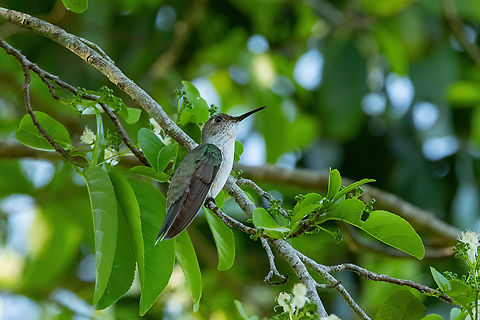
Appearance
The olive-spotted hummingbird is 12 cm long and weighs about 6 g. The sexes are assentially the same. The have a straight blackish bill; the female's is slightly longer than the male's. Adults have a bronze crown and neck and the rest of their upperparts are grayish green to bronze-green. Their throat is olive green that sometimes appears speckled with golden green and the rest of the underparts are whitish. Their tail is pale grayish green to olive green with grayish tips on the inner feathers and grayish outer webs to the others. The outer feathers also have a dark bar near the end. Juveniles are very similar but have more grayish brown underparts.Distribution
The olive-spotted hummingbird is found along the upper Amazon River and its major tributaries in northwestern Brazil, eastern Ecuador, northeastern Peru, and extreme southeastern Colombia.Status
The IUCN has assessed the olive-spotted hummingbird as being of Least Concern, though its population size and trend are unknown. No immediate threats have been identified. It is considered rare to fairly common at different points along the river system.Habitat
It has habitat requirements unique among hummingbirds: It is found almost entirely on young river islands and sometimes on the adjacent "mainland" shore. It keeps to shrubby open woodland and early successional vegetation. In elevation it occurs only up to 400 m.Reproduction
The olive-spotted hummingbird's breeding season is not known. It makes a cup nest of soft plant material and fibers bound with spiderweb with lichen on the outside. The female incubates the clutch of two eggs for 14 to 15 days and fledging occurs about 20 days after hatch.Food
The olive-spotted hummingbird forages for nectar at flowering plants of at least 10 families. In addition to feeding on nectar it gleans insects from foliage.References:
Some text fragments are auto parsed from Wikipedia.